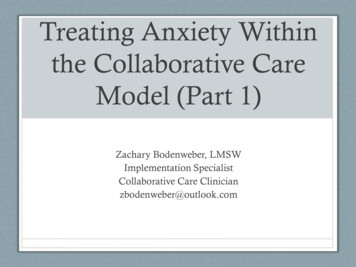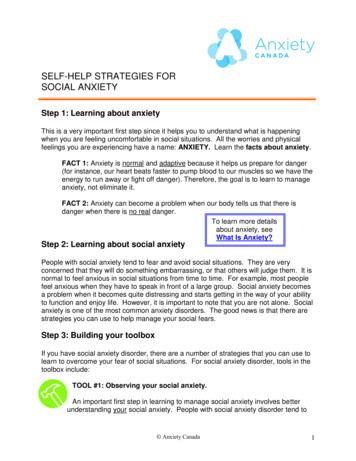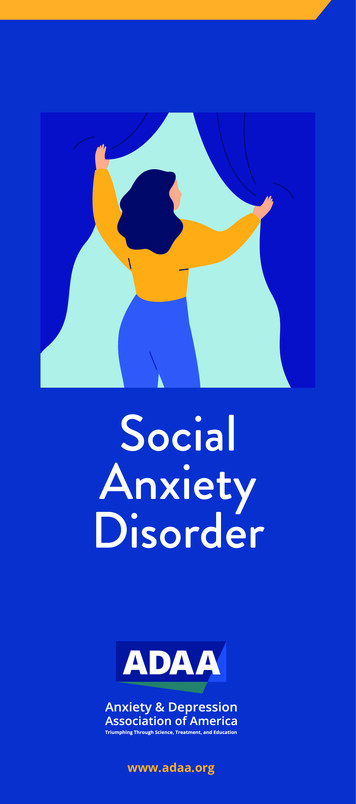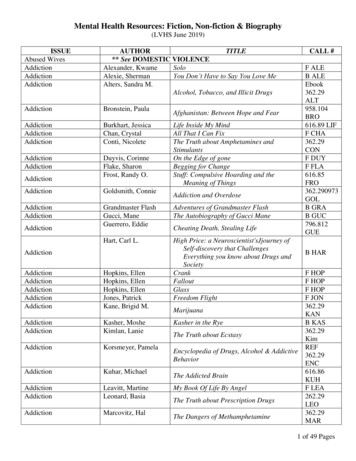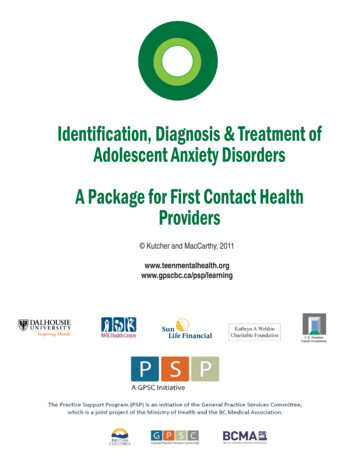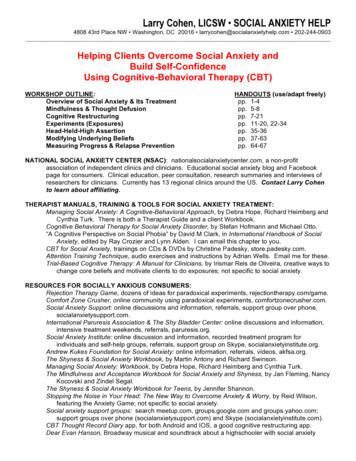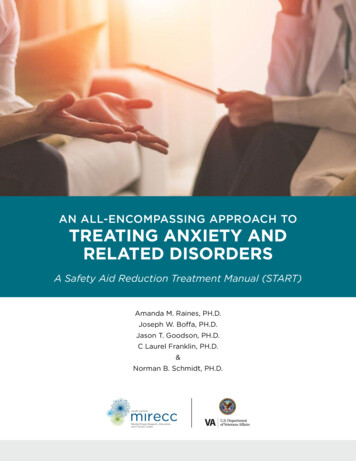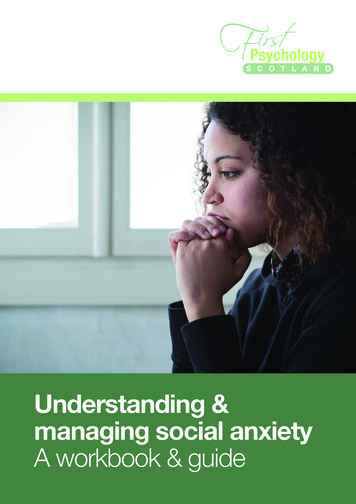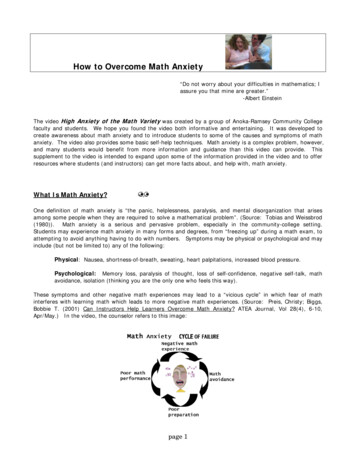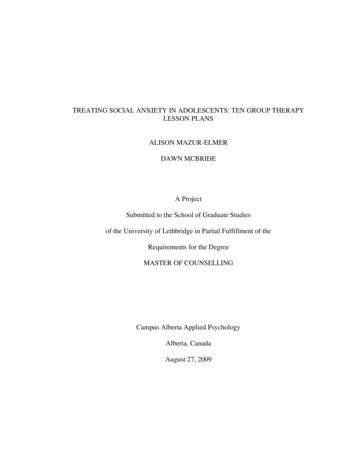
Transcription
TREATING SOCIAL ANXIETY IN ADOLESCENTS: TEN GROUP THERAPYLESSON PLANSALISON MAZUR-ELMERDAWN MCBRIDEA ProjectSubmitted to the School of Graduate Studiesof the University of Lethbridge in Partial Fulfillment of theRequirements for the DegreeMASTER OF COUNSELLINGCampus Alberta Applied PsychologyAlberta, CanadaAugust 27, 2009
AbstractThis project provides a comprehensive overview of the research literature on socialanxiety disorder (SAD) in adolescents and concludes by offering a set of 10 grouptherapy lesson plans for SAD that therapists can use in their practice. The overviewincludes a description of social anxiety disorder and highlights various theories ofanxiety. The etiology of social anxiety disorder, sex and age differences in thedevelopment of anxiety, the maintenance of SAD, and the assessment of SAD are alsoaddressed. The project devotes considerable attention to the treatment the of socialanxiety disorder through the use of cognitive behavioural therapy. The view that grouptherapy is a valid form of treatment for social anxiety disorder is advocated throughoutthis applied project.
Table of ContentsChapter One .1Introduction .1Project Rationale .2Statement of Personal Interest .3Project Structure.4Glossary .4Chapter Two.7Methods.7Chapter Three.9Literature Review: Treating Social Anxiety in Adolescents .9Adolescence: Developmental Considerations.9Normative Versus Atypical Development .10Social Anxiety .13Theories of Anxiety .13Anxiety Versus Fear .13Etiology of Social Anxiety Disorder.14Onset of Social Anxiety Disorder .16Gender Differences in the Development of SAD .16Co-Morbidity .18Maintenance of Social Anxiety Disorder .18Review of Cognitive Behavioural Theory .20Treating Social Anxiety Disorder with Cognitive Behavioural Therapy .22
Psychoeducation .23Systematic Desensitization .24Relaxation Training .25Rational Emotive Therapy .25Social Skills Training .26Effectiveness of Cognitive Behavioural Group Therapy .27Summary of the Findings .31Group Therapy for Adolescents .32Discovering Similarities.33Developing Social Skills .33Fears Impacting Enrolment in Group Therapy .34Getting the Anxious Individual to Group Therapy .35Summary .36Chapter Four .38Assessing for Social Anxiety Disorder .38Purpose of Assessment .38Assessment Instruments .40Multidimensional Anxiety Scale for Children .40The Anxiety Disorders Interview Schedule .42Chapter Five .44Overview of issues involved in a Group Therapy Program .44Group Screening .44Ethical Considerations .46
Informed Consent.46Expectations of Group Facilitators .46Supervision .47Expectations of Group Participants .47Assessment of Client Satisfaction .47Group Structure .48Parent Meetings .48Group Marketing .49Overview of Lesson Plans .49Chapter Six.50Synopsis .50Strengths of the Literature Review .52Limitations of the Literature Review .53Areas of Future Research .55Closing Remarks .56References .58Appendices .68Appendix A .68Group Therapy Lesson Plans .68Pre- Group Session .68Session One - Group Formation .72Session Two - Anxiety-What does it mean to me? .77Session Three – Disputing Irrational Thoughts .84
Session Four – Externalization .92Session Five – Relaxation Training .96Session Six – Introduction to Exposure .103Session Seven – Mindfulness.108Session Eight – Termination .112Post-Group Session .115Appendix B. Consent Form .118Appendix C. Group Therapy Information Sheet.124Appendix D. Weekly Feedback Form .126Appendix E. Program Evaluation Form.127
1Chapter OneIntroductionThis project is intended to provide counsellors with an increased understanding ofadolescent social anxiety, including but not limited to the assessment and treatment ofsocial anxiety in adolescents. Furthermore, it is intended to address the growingphenomenon of social anxiety disorder in adolescents, provide a rationale for and adescription of facilitator sample lesson plans designed to be used in the treatment ofsocial anxiety in adolescents (see Appendix A). This chapter provides a brief introductionto social anxiety disorder, identifies the purpose and importance of the final project,articulates the writer’s reasons for choosing the final project, outlines the structure andformat of the final project, and provides a glossary of terms utilized throughout theproject.Mental illnesses touch the lives of the majority of Canadians, impactingrelationships, education, productivity, and overall quality of life (Health Canada, 2002).According to Health Canada, approximately 20%of individuals will experience a mentalillness during their lifetime and the remaining 80% will be affected by mental illness infamily members, friends or colleagues.Of all the mental disorders, anxiety disorders affect the greatest number ofchildren and adolescents (Reinecke, Dattilio, & Freeman, 2006). Although certain fearsand anxieties may be both normative and transient in particular developmental periods,the level of fear or anxiety in some adolescents exceeds developmental expectations,significantly undermining functioning at home, at school, and with peers (Kazdin &Weisz, 1998).
2Social anxiety disorder (SAD) is a chronic condition characterized by heightenedself-consciousness and exaggerated fear of negative evaluation, which may be limited orgeneralized to a variety of social contexts (Brady & Kendall, 1992). The fourth edition ofthe Diagnostic Statistical Manual for Mental Disorders, Text Revision (DSM-IV-TR)defines the essential features of SAD as, “A marked and persistent fear of social orperformance situations in which embarrassment may occur” (American PsychiatricAssociation, 2000, p. 450).Project RationaleSocial anxiety disorder is a condition warranting attention by both clinicians andresearchers. With onset in late-childhood, social anxiety disorder can interfere withfriendships, academics, and critical developmental tasks (Velting & Albano, 2001). Leftuntreated, the consequences of social anxiety disorder are far-reaching in to adulthood,resulting in serious compromises to an individual’s ability to live independently and tohis or her full potential (Reinecke et al., 2006).Evidence suggests that social anxiety disorder in not a transient problem fromwhich young people necessarily recover without some form of intervention; which is whyattention to childhood social anxiety is important (Kashdan & Herbert, 2001; Spence,Donovan, & Brechman-Toussaint, 2000). Beidel, Fink, and Turner (1996) conducted asix month study of 26 children aged 7 to 12 years who received a diagnosis of SAD, butdid not receive treatment. The majority (62 %) retained their diagnosis over the six monthfollow-up period. Only 17% of the children showed dissipation of their social anxietyover the six-month follow-up. Studies with socially anxious adults indicate that themajority of adults had late childhood onset (Zaider & Heimberg, 2003).
3Statement of Personal InterestI am addressing the topic of social anxiety in adolescents as despite being one ofthe most prevalent disorders of childhood and adolescence, social anxiety disorderparadoxically stands out as one of the least recognized, researched, and treated paediatricdisorders (Kashdan & Herbert, 2001). The high prevalence, seriousness, and early onsetof SAD make a review of the literature on adolescent SAD timely. Epidemiologicalstudies have found SAD to be the most common anxiety disorder and the third mostprevalent psychiatric condition in the United States, affecting up to 15% of individuals atsome point during their lifetime (Khalid-Khan, Santibanez, McMicken, & Rynn, 2007).Studies in other western nations (e.g., Canada & Australia) noted similar prevalence rates(Iancu, Levin, & Hermesh, 2006).Studies have demonstrated that psychosocial treatments, specifically cognitivebehavioural therapy and group therapy, are efficacious in treating paediatric SAD(Khalid-Khan, Santibanez, McMicken, & Rynn, 2007). As such, I am interested inexamining the efficacy of cognitive behavioural group therapy for adolescents with socialanxiety.Furthermore, as I treat a high percentage of adolescents who qualify for adiagnosis of SAD, I felt it necessary to create a series of sample lesson plans that targetthis particular age group. Due to the cognitive, social, and emotional advances during theteen years, I wanted to create a manualized CBT program for youth that is based upon thedevelopmental abilities of this age group. Additionally, I thought it essential to create aresource that is practical and implements creative strategies for engaging with youth in
4treatment. My intention was to create a resource that could be utilized by myself andother therapists in the treatment of social anxiety.Project StructureMethods utilized to complete this project will be presented in Chapter Two.Chapter Three provides a literature review beginning with a description of social anxietyand developmental considerations in adolescents. Theories of anxiety will also bepresented in Chapter Three, including the etiology of SAD, gender differences in thedevelopment of anxiety, the maintenance of SAD, and the treatment of SAD throughcognitive behavioural therapy. Additionally, group therapy will be presented as a form oftreatment for SAD and the pros and cons of this modality in the treatment of SAD will beexplored. Chapter Four focuses on assessment tools used to assess for adolescent socialanxiety. Chapter Five provides an overview of key issues that should be involved in agroup therapy program and the attached lesson plans found in Appendix A. Chapter Sixoutlines the strengths and limitations of the literature review and provides direction forfuture research.GlossaryAdolescence: A transitional stage of physical and mental human development that occursbetween childhood and adulthood. This transition involves biological (i.e.,pubertal), social, and psychological changes.Anxiety: A state of apprehension, uncertainty, and fear resulting from the anticipation ofa realistic or fantasized threatening event or situation, often impairing physicaland psychological functioning.
5Behavioural Theory: A school of psychology that studies observable and quantifiableaspects of behaviour and excludes subjective phenomena, such as emotions ormotives.Biological Models: A theoretical view that holds that mental disorders are caused byabnormal somatic processes or defects.Cognitive Distortion: Pervasive and systematic error in reasoning.Cognitive Restructuring: An active attempt to alter maladaptive thought patterns andreplace them with more adaptive cognitions.Cognitive Theory: An approach that focuses on how thoughts and personal beliefs play arole in the development of maladaptive behaviour including negative schemataand interpretations of ones self, the world and the future.Comorbidity: The co-occurrence of two disorders, as when a person is both anxious anddepressed.Diagnostic and Statistical Manual of Mental Disorders (DSM-4th Edition-Text Revision):A publication of the American Psychiatric Association delineating specific anddiscrete symptoms of mental disorders.Facilitator: An individual who leads a group in accomplishing specific goals.Group Therapy: A form of psychotherapy in which one or more therapists treat a smallgroup of clients together as a group. Refers to any form of psychotherapy whendelivered in a group format, including cognitive behavioural therapy orinterpersonal therapy, but is usually applied to psychodynamic group therapy(where the group context and group process is explicitly utilized as a mechanism
6of change by developing, exploring and examining interpersonal relationshipswithin the group).Panic Attack: A clinical term used to describe the experience of intense fear, resulting inphysiological arousal and a variety of somatic and cognitive symptoms.Psychopathology: A term which refers to either the study of mental illness or mentaldistress, or the manifestation of behaviors and experiences which may beindicative of mental illness or psychological impairment, such as abnormal,maladaptive behavior or mental activity.Social Anxiety: Refers to the tendency to be nervous or uncomfortable in socialsituations, usually because of fear about doing something embarrassing, making abad impression, or being judged negatively by others.State Anxiety: An unpleasant emotional arousal in the face of perceived or realthreatening demands or dangers.Systematic Desensitization: A step-by-step procedure for replacing anxiety withrelaxation while gradually increasing exposure to an anxiety-producing situationor object.
7Chapter TwoMethodsThis chapter outlines the research methods that were used to complete this project.Correspondingly, this chapter includes a synopsis of the literature reviewed, as well as thesearch terms and databases that were explored.This project explores what the literature reveals about: (a) the definition andclassification of social anxiety; (b) the epidemiology, course, and prognosis of socialanxiety; (c) co-morbidity with other disorders; (d) diagnosis of social anxiety andinstruments utilized to assess for social anxiety; (e) treatment of social anxiety disorder inadolescents; (f) psychosocial treatments and their effectiveness; and (g) group therapy foradolescents.The literature review used the following electronic databases: Child Developmentand Adolescent Studies; PsychInfo; Psychology and Behavioral Sciences Collection;Mental Measurements Yearbook; and Internet resources such as Google Scholar. Searchterms used included but were not limited to: adolescence; youth; development; anxiety;social anxiety; phobia disorder; assessment; diagnosis; epidemiology; co-morbidity;treatment; cognitive behavioural therapy; psychosocial interventions; and group therapy.This project explored studies and materials from peer-reviewed journal articles,books, manuals, workbooks, and handbooks that examined the impact and treatment ofsocial anxiety in adolescents. This project did not involve human subjects. Some of thematerial in the appendices of this project was originally part of an assignment in one ofmy past courses. However, the material included in the appendices has been substantially
8expanded, redesigned and revised to be of service to therapists interested in working withSAD clients.
9Chapter ThreeLiterature Review: Treating Social Anxiety in AdolescentsThe intent of this paper is to provide a comprehensive overview of the researchliterature related to social anxiety in adolescents. Given that adolescence is adevelopmental period that constitutes potential for conflict as well as opportunity forgrowth, understanding the conflicts that arise for individuals attempting to overcomebarriers and obstacles along their developmental paths may provide insights into thesubsequent development and expression of emotional difficulties. This chapter willtherefore begin with a review of the normative and atypical developmental processes ofadolescents. Following this, components of anxiety will be discussed including; (a) adescription of social anxiety; (b) theories of anxiety, including the onset and etiology ofSAD; (c) gender differences in the development of SAD; (d) co-morbidity; (e)maintenance of SAD; and (f) treatment of SAD. The chapter will also present empiricalreviews supporting the efficacy of cognitive behavioural group therapy in the treatmentof SAD.Adolescence: Developmental ConsiderationsAdolescent development is described in the literature in terms of three processes:biological, cognitive and socio-emotional (Santrok, 2001). Biological processes consist ofan individual’s unique biological make-up, which genetically influences behaviour anddevelopment (Santrok). Biologically determined processes of development weredominant viewpoints in the early twentieth century. For example, Stanley Hall (as cited inSantrok), often thought of as the father of scientific study of adolescence, believed that
10development was predominantly biologically determined, with environmental factorsplaying a minimal role.Cognitive processes incorporate changes in an individual’s thinking throughoutthe course of development (Albano & Kendall, 2002). This view emphasizes thatadolescents have sophisticated thinking abilities and are motivated to understand andconstruct their own cognitive worlds (Albano & Kendall). Theorists focus on individualdifferences involving complex cognitive abilities including problem solving abilities,memory capacity, and decision making (Albano & Kendall). Current strides within thisperspective include examining how individuals within this age group apply criticalthinking and are able to adapt competently within their environment (Albano & Kendall).Socio-emotional processes involve the development of individual emotions inrelation to social contexts and other people (Santrok, 2001). Research suggests thatimportant context in child and adolescent development includes family, peer, school andculture (Santrok). In addition, social and personality development interact withenvironmental situations to further complicate this investigative process (Santrok).In summary, biological, cognitive and socio-emotional processes are intricatelyrelated and constantly interacting. A holistic perspective of adolescent developmentpurports that changes in adolescent development are an outcome of all three processes(Santrok, 2001).Normative Versus Atypical DevelopmentOne of the greatest challenges it appears in studying adolescents is reaching anunderstanding of the nature of normal versus abnormal development, and the relationshipbetween the two. Given that the literature on adolescent psychopathology seems to lag
11behind that of adult psychopathology (Kashdan & Herbert, 2001), it is not surprising thatthere is a gap in what we know about adolescent psychopathology. Researchers are stillunclear on several issues pertaining to the development of psychopathology inadolescence, some of which will be outlined next.First, many theorists have questioned whether the development ofpsychopathology in adolescence is a result endogenous to the child, an outcome due toenvironmental circumstance, or a reaction to both (Mash & Dozois, 1996). Second,theorists have pondered how to conceptualize the development of psychopathology – is itcategorically distinct from normal functioning, or, is it an extreme point on a continuumof development (Mash & Dozois). Third, psychopathology can be viewed as a static ordynamic process influenced by both individual developmental changes andenvironmental chances (Mash & Dozois).Most theorists agree that adolescents are faced with numerous developmentaldemands, from dealing with hormonal changes to emotional regulation, while in anattempt to successfully adapt (Dozois & Dobson, 2004; Kashdan & Herbert, 2001; Price& Lento, 2001). Moreover, psychopathology lends itself to a form of maladaptationresulting from difficulties in adapting to developmental demands (Dozois & Dobson).Understanding atypical development is only possible when looking at the whole pictureof normative development.Many theories have been developed in an attempt to explain development in termsof stages, focusing on specific changes that occur at each stage, and progressing to thenext stage in order to reach a functional level as an adult. For instance, Piaget’s (as citedin Berk, 2000) theory emphasized that a critical stage in adolescence was developing
12abstract thinking. Another stage theorist, Eric Erikson (as cited in Berk) focused onpsycho-social stages within adolescent development proposing that this is a period whereeach adolescent formulates their own identity. The risk of identity confusion is includedin Erikson’s psychosocial stages identified as occurring in the transition betweenchildhood and adulthood (as cited in Berk). Erikson (as cited in Berk) described this riskas feelings of isolation, doubt, anxiety and indecision. Furthermore, these traits mayinterfere with the individual’s ability to enter the next stage of development (Berk).Research has demonstrated that adolescence is a critical period for understandingthe etiology and course of emotional disorders (Price & Lento, 2001). Chorpita andBarlow (1998) developed a model to test the effects of early life experiences andperceived lack of control on the development of specific cognitions that certain eventsmay be out of one’s control. Findings demonstrated that the specific cognitions testedrepresented a psychological vulnerability for the development of both anxiety anddepression. Chorpita and Barlow inferred that if a lack of perceived control over a givensituation makes one vulnerable to maladjustment, then perceived control might contributeto normative development.Unfortunately, anxiety is often dismissed as a developmentally normal componentof a teenager’s life (Price & Ingram, 2001). This perception may explain the lack ofexisting research about emotional difficulties in adolescence.Theorists have also examined abnormal development in adolescence by focusingon individuals who are generally at risk. No single theory has been able to capture thewhole picture of normative or abnormal development (Price & Ingram, 2001). Theinability of a single theory to explain all aspects should not be seen as a shortcoming.
13However, studying specific aspects of abnormal development may be advantageous inpreventative approaches.Social AnxietyAccording to the fourth edition of the Diagnostic Statistical Manual IV-TR(American Psychiatric Association, 2000) anxiety disorders can be broken into thefollowing types: panic disorders; agoraphobia; specific phobia; social phobia; obsessivecompulsive disorder; posttraumatic stress disorder; acute distress disorder; generalizedanxiety disorder; anxiety disorder due to a general medical condition; substance-inducedanxiety; and anxiety disorder not otherwise specified. Several symptoms are common tothe range of anxiety disorders, such as “a sense of uncontrollability focused on possiblefuture threat, danger, or other anticipated, potentially negative events” (AmericanPsychiatric Association, p. 429).Upon exposure to social situations, an individual may experience anxiety in theform of situational specific or situationally predisposed panic attacks (Khalid-Khan et al.,2007). The individual with SAD will endure social situations with intense distress and/orescape from it in order to avoid anxiety-provoking situations (Khalid-Khan et al.). Assuch, the consequence of the anxiety and resultant avoidance patterns often impairs andinterferes with the individual’s normal routine, social and/or family life, oroccupational/academic functioning (Khalid-Khan et al.). According to Kearney (2001),youth with SAD may avoid and/or be unable to tolerate a wide and generalized range ofsituations and activities, which may include the ability to attend or stay in school.Theories of AnxietyAnxiety Versus Fear
14Fear and anxiety can be experienced at minimal levels and can be normal andadaptive in many situations. In its adaptive form, anxiety serves a protective function forthe individual, alerting him or her to danger and motivating certain adaptive behavioursto avoid stress or negative experiences (Albano & Kendall, 2002). Such motivation arisesfrom physiological arousal occurring in the form of autonomic nervous system activity(Albano & Kendall). These responses prepare an individual to respond with appropriatemotor behaviour in stressful situations (Albano & Kendall).Certain fear and anxiety reactions have been well documented as normal andexpected processes at different developmental levels; for example, young children oftenfear the dark, separation, and small animals, while adolescents often fear evaluations(tests, oral presentations and social situations) (Albano, Causey, & Carter 2001;Castellanos & Hunter, 1999).Etiology of SADPsychodynamic, cognitive behavioural and, more recently integrated theories,have all attempted to explain the origins of anxiety. Psychodynamic theories havefocused mainly on underlying unresolved conflicts that individuals express through thesymptomatology of anxiety (Davison, Neale, Blakstein, & Fleet, 2005). For example, ateen might be anxious due to his unresolved feelings of anger towards his father.Sigmund Freud (as cited in Barlow & Durand, 2005) viewed anxiety as a defencemechanism for repressed and unconscious impulses; however, there is little empiricalevidence to support psychodynamic assumptions (Davison et al.).Cognitive theorists assert that social anxiety is related to emotions caused bynegative interpretations and beliefs (Antony & Swinson, 2000). Anxiety and fear often
15occur when a person interprets a situation as threatening or dangerous. Although fearfulpredictions and interpretations are sometimes accurate, they are often exaggerated orinaccurate (Antony & Swinson). Anxious thinking begins and persists when people, suchas teens, make in
Social anxiety disorder is a condition warranting attention by both clinicians and researchers. With onset in late-childhood, social anxiety disorder can interfere with friendships, academics, and critical developmental tasks (Velting & Albano, 2001). Left untreated, the consequences of social anxiety disorder are far-reaching in to adulthood,

